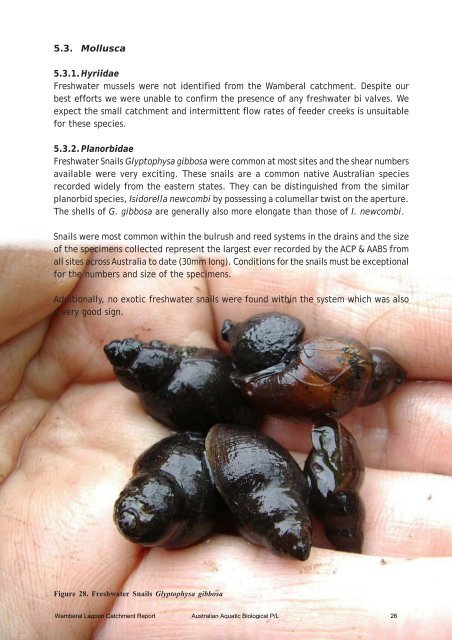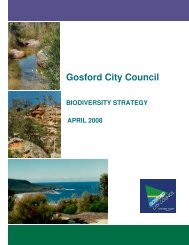Wamberal Lagoon Catchment Aquatic Survey Final Report (PDF ...
Wamberal Lagoon Catchment Aquatic Survey Final Report (PDF ...
Wamberal Lagoon Catchment Aquatic Survey Final Report (PDF ...
You also want an ePaper? Increase the reach of your titles
YUMPU automatically turns print PDFs into web optimized ePapers that Google loves.
5.3. Mollusca<br />
5.3.1. Hyriidae<br />
Freshwater mussels were not identified from the <strong>Wamberal</strong> catchment. Despite our<br />
best efforts we were unable to confirm the presence of any freshwater bi valves. We<br />
expect the small catchment and intermittent flow rates of feeder creeks is unsuitable<br />
for these species.<br />
5.3.2. Planorbidae<br />
Freshwater Snails Glyptophysa gibbosa were common at most sites and the shear numbers<br />
available were very exciting. These snails are a common native Australian species<br />
recorded widely from the eastern states. They can be distinguished from the similar<br />
planorbid species, Isidorella newcombi by possessing a columellar twist on the aperture.<br />
The shells of G. gibbosa are generally also more elongate than those of I. newcombi.<br />
Snails were most common within the bulrush and reed systems in the drains and the size<br />
of the specimens collected represent the largest ever recorded by the ACP & AABS from<br />
all sites across Australia to date (30mm long). Conditions for the snails must be exceptional<br />
for the numbers and size of the specimens.<br />
Additionally, no exotic freshwater snails were found within the system which was also<br />
a very good sign.<br />
Figure 28. Freshwater Snails Glyptophysa gibbosa<br />
<strong>Wamberal</strong> <strong>Lagoon</strong> <strong>Catchment</strong> <strong>Report</strong> Australian <strong>Aquatic</strong> Biological P/L 26

















